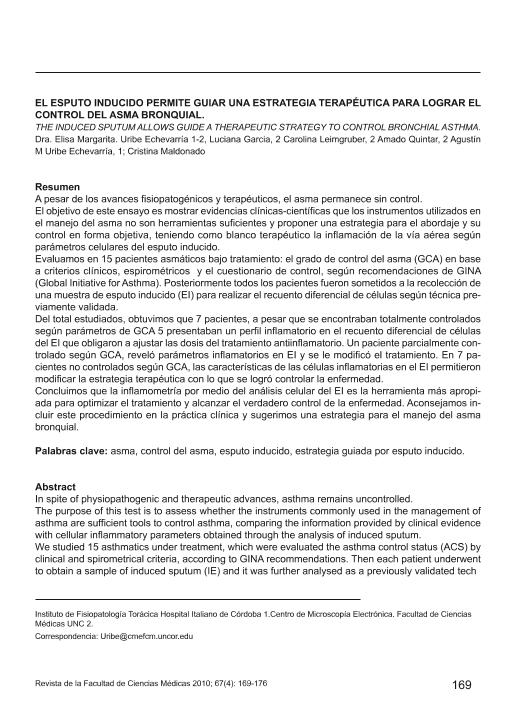Artículo
A pesar de los avances fisiopatogénicos y terapéuticos, el asma permanece sin control.El objetivo de este ensayo es mostrar evidencias clínicas-científicas que los instrumentos utilizados enel manejo del asma no son herramientas suficientes y proponer una estrategia para el abordaje y sucontrol en forma objetiva, teniendo como blanco terapéutico la inflamación de la vía aérea segúnparámetros celulares del esputo inducido.Evaluamos en 15 pacientes asmáticos bajo tratamiento: el grado de control del asma (GCA) en basea criterios clínicos, espirométricos y el cuestionario de control, según recomendaciones de GINA(Global Initiative for Asthma). Posteriormente todos los pacientes fueron sometidos a la recolección deuna muestra de esputo inducido (EI) para realizar el recuento diferencial de células según técnica pre-viamente validada.Del total estudiados, obtuvimos que 7 pacientes, a pesar que se encontraban totalmente controladossegún parámetros de GCA 5 presentaban un perfil inflamatorio en el recuento diferencial de célulasdel EI que obligaron a ajustar las dosis del tratamiento antiinflamatorio. Un paciente parcialmente con-trolado según GCA, reveló parámetros inflamatorios en EI y se le modificó el tratamiento. En 7 pa-cientes no controlados según GCA, las características de las células inflamatorias en el EI permitieronmodificar la estrategia terapéutica con lo que se logró controlar la enfermedad.Concluimos que la inflamometría por medio del análisis celular del EI es la herramienta más apropi-ada para optimizar el tratamiento y alcanzar el verdadero control de la enfermedad. Aconsejamos in-cluir este procedimiento en la práctica clínica y sugerimos una estrategia para el manejo del asmabronquial. In spite of physiopathogenic and therapeutic advances, asthma remains uncontrolled. The purpose of this test is to assess whether the instruments commonly used in the management of asthma are sufficient tools to control asthma, comparing the information provided by clinical evidence with cellular inflammatory parameters obtained through the analysis of induced sputum. We studied 15 asthmatics under treatment, which were evaluated the asthma control status (ACS) by clinical and spirometrical criteria, according to GINA recommendations. Then each patient underwent to obtain a sample of induced sputum (IE) and it was further analysed as a previously validated tech nique. From the total number of patients, 7 were total controlled patients according to ACS; only 2 of them had a normal IE cellular pattern while the other 5 presented an inflammatory profile in the differential cells count of the IE, forced to make adjustments in the anti-inflammatory treatment. One partially controlled patient by ACS, revealed inflammatory parameters in IE allowing modify the therapeutic schema. In 7 not controlled patients by ACS, the cellular inflammatory characteristics in IE, allowed modify therapeutic strategy which achieved control of the disease. We concluded that inflamommetry by IE cellular analysis is the tool that contributes to optimize the treatment and achieve true control of the disease. We suggest including this procedure in clinical practice and proposing a strategy for the management of asthma.
El esputo inducido permite guiar una estrategia terapéutica para lograr elcontrol del asma bronquial
Uribe Echevarria, Elisa Margarita; García, Luciana Noemí ; Leimgruber, Carolina
; Leimgruber, Carolina ; Quintar, Amado Alfredo
; Quintar, Amado Alfredo ; Uribe Echevarria, Agustin M.; Maldonado, Cristina Alicia
; Uribe Echevarria, Agustin M.; Maldonado, Cristina Alicia
 ; Leimgruber, Carolina
; Leimgruber, Carolina ; Quintar, Amado Alfredo
; Quintar, Amado Alfredo ; Uribe Echevarria, Agustin M.; Maldonado, Cristina Alicia
; Uribe Echevarria, Agustin M.; Maldonado, Cristina Alicia
Fecha de publicación:
12/2010
Editorial:
Universidad Nacional de Córdoba. Facultad de Ciencias Médicas
Revista:
Revista de la Facultad de Ciencias Médicas
ISSN:
0014-6722
e-ISSN:
1853-0605
Idioma:
Español
Tipo de recurso:
Artículo publicado
Clasificación temática:
Resumen
Palabras clave:
Asma
,
Control del Asma
,
Esputo Inducido
Archivos asociados
Licencia
Identificadores
Colecciones
Articulos(CCT - CORDOBA)
Articulos de CTRO.CIENTIFICO TECNOL.CONICET - CORDOBA
Articulos de CTRO.CIENTIFICO TECNOL.CONICET - CORDOBA
Articulos(INICSA)
Articulos de INSTITUTO DE INVESTIGACIONES EN CIENCIAS DE LA SALUD
Articulos de INSTITUTO DE INVESTIGACIONES EN CIENCIAS DE LA SALUD
Citación
Uribe Echevarria, Elisa Margarita; García, Luciana Noemí; Leimgruber, Carolina; Quintar, Amado Alfredo; Uribe Echevarria, Agustin M.; et al.; El esputo inducido permite guiar una estrategia terapéutica para lograr elcontrol del asma bronquial; Universidad Nacional de Córdoba. Facultad de Ciencias Médicas; Revista de la Facultad de Ciencias Médicas; 67; 4; 12-2010; 169-176
Compartir



